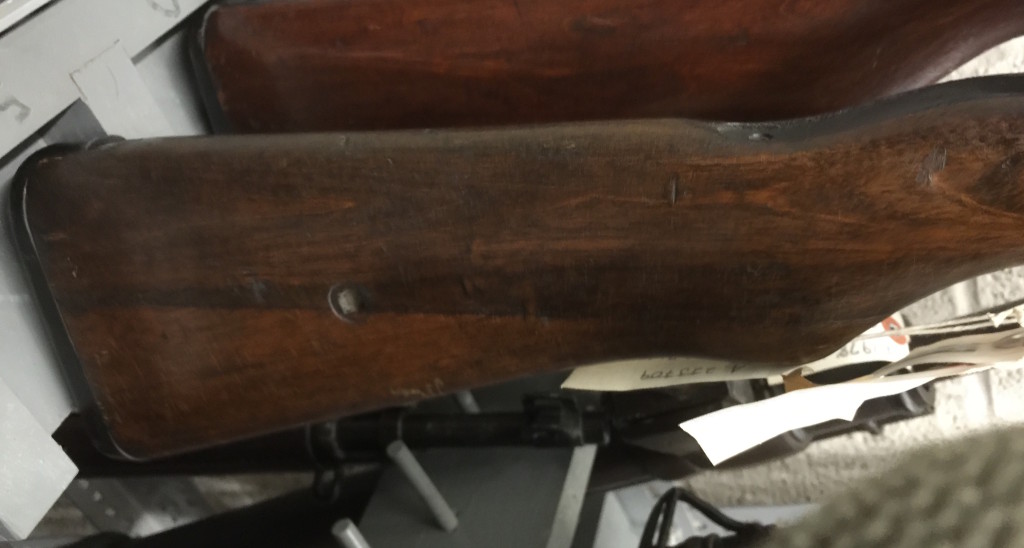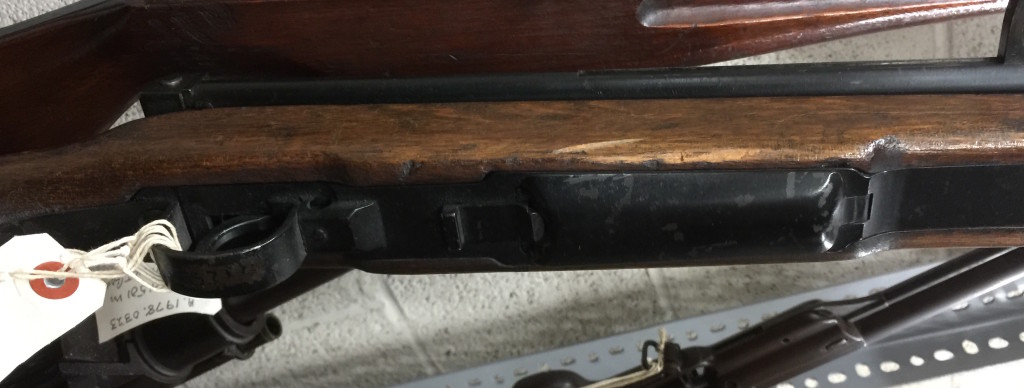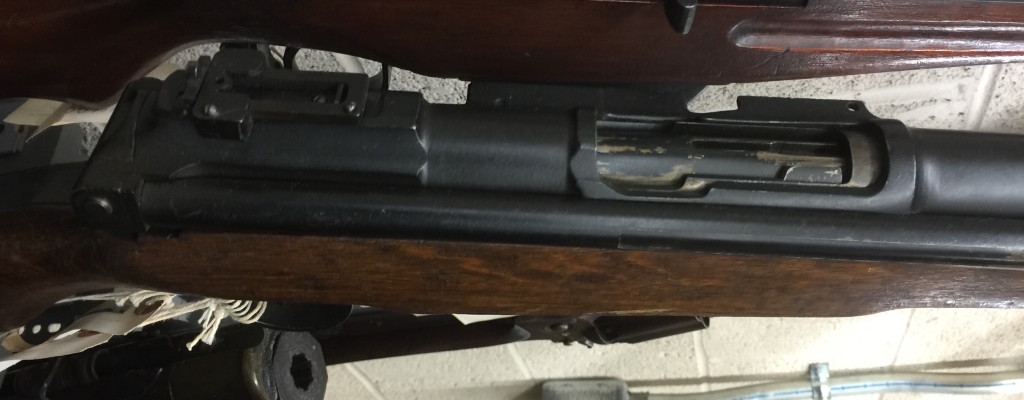While in the Smithsonian gun room, I noticed a semi auto Japanese rifle of a type I have not seen reference to before. It is definitely Japanese, judging from elements like the split buttstock and rear sight, and the ventilated underside of the hand guard is reminiscent of the Japanese Pedersen rifles. However, this rifle uses a rotating bolt and a receiver design that I am not familiar with.
Has anyone seen this before? The tag on it said it was a Type 5, which believe was a mix-up with the rifle next to it on the rack (which was a Type 5 Japanese copy of an M1). Click on the photos to enlarge:







What’s up with the hinge in the middle? Is it a take down model?
Anymore photos? Any full length photos?
No idea. I think i see lot of western influence though.
“western influence”
Russian Справочник по стрелковому оружию иностранных армий from 1947 states (page 146, chapter: Japan) that:
SELF-LOADING RIFLE ZH-32
Self-loading rifle ZH-32 of Czechoslovak «Zbrojovka Brno», model 1932, after testing was adopted by Japanese Cavalry.
Mechanically this rifle is same as ZH-29.
MAIN PARAMETERS:
Caliber: 7,7mm
Length: 1140mm
Barrel length: 590mm
Mass: 4,5kg
Magazine capacity: 5 or 10
Maximal sight distance: 1400m
Interesting; coincidentally, my immediate thought was that the rifle’s receiver architecture looked a lot like the Czech ZK-420S
That was my first thought as well, although without getting the bolt out of it that’s just off of vague appearance. I’m guessing it’s not ZH-29 based, though, seeing as it looks like the barrel is in line with the receiver.
The linked book below says the ZH-32 was outwardly identical to the ZH-29. The ZH-29 photo on wikipedia doesn’t look like a match, but there are some similarities. It was purchased by the Chinese, so maybe a prototype/demonstration rifle that never made production?
https://books.google.com/books?id=Eq2Dnj4sDZIC&pg=PA180&lpg=PA180&dq=RIFLE+ZH-32&source=bl&ots=scrvmcMDyM&sig=ZCbuJcy1GD9ZFeNIkUlEwOZt3DY&hl=en&sa=X&ved=0ahUKEwjr3pOQiebJAhXBzz4KHWOYDvIQ6AEIPTAH#v=onepage&q=RIFLE%20ZH-32&f=false
Awesome !
Caliber 7.7,uses some type99 hardware, is gas operated,has MAS 36 style front barrel band…
Yet the operation rod is side mounted ,with the charging handle on the left side. The bore and bolt face are satin chrome plated. It has Stripper clip guides machined into the bolt carrier. It has a ten shot magazine,that is unreliable due to poor spring quality.This was the major reason for rejection .
It has no model designation.
I see a lot of small parts that are reminiscent of the Arisaka bolt action rifle. Re: rear sight, front sight, configuration of the trigger guard, and the way that the floor plate is latched. I’m sure they were developing a semi-auto, as the bolt action rifle….against the M1 Garand….was a losing proposition.
According to W.H.B. Smith & Joseph E. Smith in The Book of Rifles (1964 ed.);
The latter statement may be a bit off, as the Nambu LMG was of course based on the French Hotchkiss system. But the rifle could have been a parallel development also based on that system.
Captain Hino was I believe the same man who was involved in the Hino-Komuru blow-forward pistol design.
Is it possible that this rifle is the 1904 Nambu/Hino test article, or one similar to it?
cheers
eon
This wouldn’t be one of those Japanese “Garands” would it? IE one of the semiauto rifles that were copies of our service gun.
No, but there was one of those right next to it in the rack.
Does it anywhere has Imperial Chrysanthemum?
https://en.wikipedia.org/wiki/Imperial_Seal_of_Japan
Which caliber it fire – 6.5x50SR Arisaka xor 7.7×58 Arisaka? If not know what is internal diameter of barrel (lands)?
It almost looks like some one took parts from an Ariska, a Type 5, a Pederson and a few others and had an open mike night at the smithing table…I am now very curious.
sadly there no picture that show the rifle complete
but looking at muzzle and Ventilation on the underside
I think that is a Model 99 rifle, there were two derivates, one for Snipers and for Paratroopers
either one of two could be that rifle on Photo
http://stat.ameba.jp/user_images/20121012/16/tatsutoti/1c/0b/j/o0640050512233148123.jpg
The muzzle of this rifle look like the third and fourth of the image of top link. I guess this mystery rifle was made by “小倉工廠”
Looking forward to hearing about this when you figure it out! ^__^
Have you found a catalog entry for it anywhere? I bet there are quite a few lost treasures in there!
Oh fiddlesticks! I can’t tell what’s going on here!
It must be a modified experimental Kokura Rifle.Some prototypes were made by Kokura Arsenal during the Pacific War but they never went into production.By the way,the Kokura Arsenal was also the manufacturer of the unique experimental toggle lock Type A rifle which was made before the Second Sino-Japanese War.
The rifle is shown in an article “Japanese Rifles and Carbines” by M.D. Waite from American Rifleman, February issue of 1958. The author states that it is a locked-breech recoil-operated semi-automatic rifle that uses 7.7mm rimless cartridge, it feeds from 5-round box magazine and has a mounting bracket for a Japanese 2.5x scope (the one used on Type 97). Also there is a picture of the rifle’s stock being hinged down from barrel/action group (in similar way to ZH-29).
I found an online listing for this article that included a picture of the blurb on this rifle:
http://i.ebayimg.com/00/s/MTE0MFgxNjAw/z/2dYAAOSwD0lUiejH/$_57.JPG
Not sure how long that image will stay there, so grab it while you can. ^__^
Here’s the original auction listing:
http://www.ebay.ca/itm/1958-JAPANESE-RIFLES-CARBINES-All-Military-Guns-6-Page-MAGAZINE-ARTICLE-1255/261914366077
Looks as though there are two other pages to the article that aren’t shown.
Thanks! That’s the one…
Shame they don’t have this one on display.
I wonder if this is a development of the Mauser long-recoil operated rifles?
This is one page 169 of Honeycutts military rifles of Japan 5th edition. Its listed as variation of Rifle plan #1 by kokura arsenal 7.7mm for army evaluation during 1941-1943.
The expertese and scholarship that can be brought to bear by Ian’s readership never ceases to amaze me. Well done!
From the close-up of the Action it looks like one of Mauser’s 1906-08 Auto Rifles; but the Muzzle fitting could be either a “Gas trap” (Bang system) or a straight recoil system. Only a complete strip-down and examination will determine which design (or designs) Kokura put together for this Prototype.
Doc AV
Did you ever get a chance to take another look at this thing?